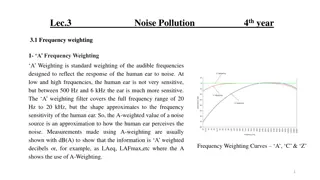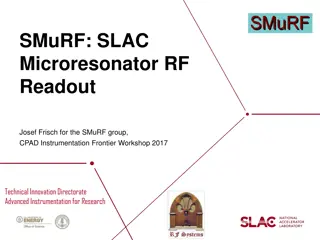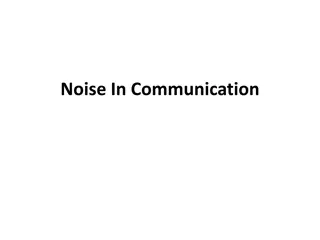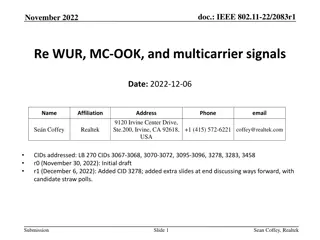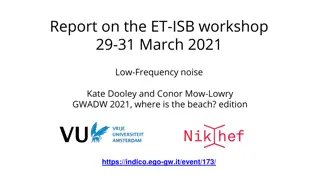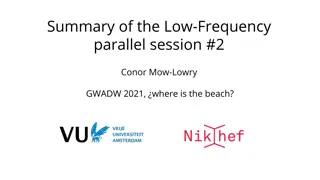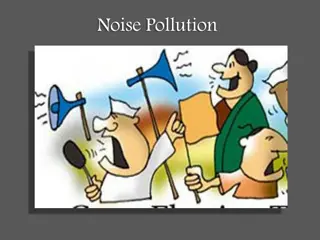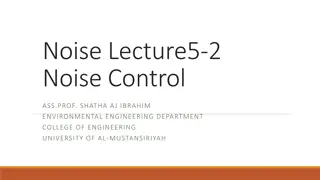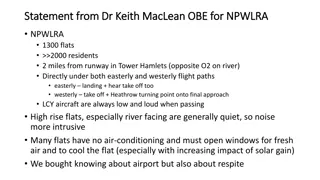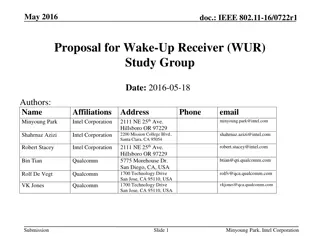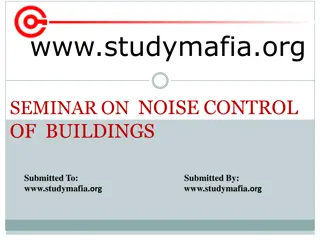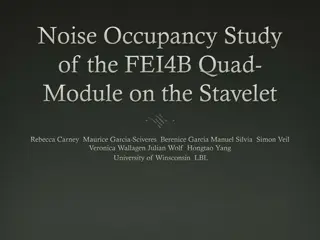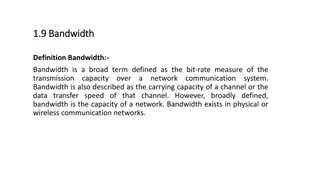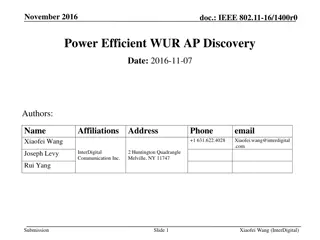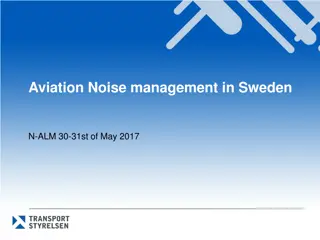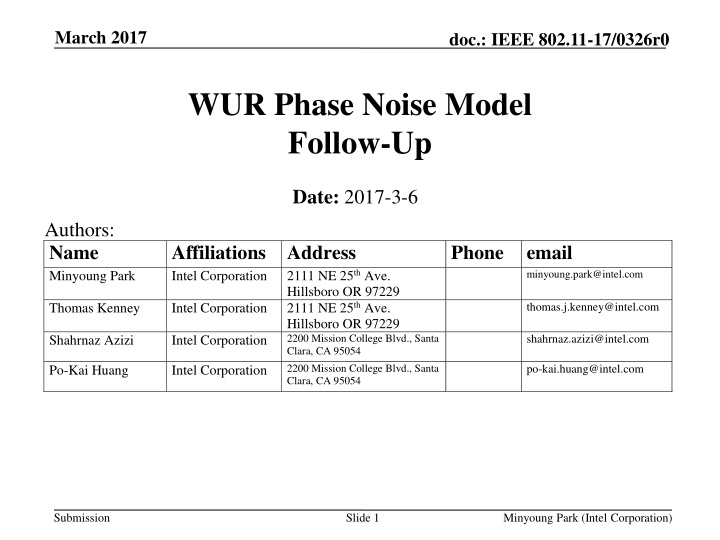
IEEE 802.11-17/0326r0 Phase Noise Model for Wake-Up Receiver
Explore the phase noise model proposed for IEEE 802.11ba wake-up receiver, considering power consumption implications. The presentation highlights the necessity of adapting a new phase noise model to align with power consumption targets set for wake-up receivers in comparison to legacy systems.
Download Presentation

Please find below an Image/Link to download the presentation.
The content on the website is provided AS IS for your information and personal use only. It may not be sold, licensed, or shared on other websites without obtaining consent from the author. If you encounter any issues during the download, it is possible that the publisher has removed the file from their server.
You are allowed to download the files provided on this website for personal or commercial use, subject to the condition that they are used lawfully. All files are the property of their respective owners.
The content on the website is provided AS IS for your information and personal use only. It may not be sold, licensed, or shared on other websites without obtaining consent from the author.
E N D
Presentation Transcript
March 2017 doc.: IEEE 802.11-17/0326r0 WUR Phase Noise Model Follow-Up Date: 2017-3-6 Authors: Name Minyoung Park Affiliations Address Intel Corporation Phone email minyoung.park@intel.com 2111 NE 25th Ave. Hillsboro OR 97229 2111 NE 25th Ave. Hillsboro OR 97229 2200 Mission College Blvd., Santa Clara, CA 95054 2200 Mission College Blvd., Santa Clara, CA 95054 thomas.j.kenney@intel.com shahrnaz.azizi@intel.com po-kai.huang@intel.com Thomas Kenney Intel Corporation Shahrnaz Azizi Intel Corporation Po-Kai Huang Intel Corporation Submission Slide 1 Minyoung Park (Intel Corporation)
March 2017 doc.: IEEE 802.11-17/0326r0 Abstract This is a follow-up presentation on the phase noise model of a wake-up receiver [1] This presentation proposes a phase noise model for 802.11ba that takes into account the power consumption of a wake-up receiver Submission Slide 2 Minyoung Park (Intel Corporation)
March 2017 doc.: IEEE 802.11-17/0326r0 Re-cap of [1] The power consumption target for a wake-up receiver is much lower than a legacy 802.11 STA WUR SG PAR [802.11-16/1045r9]: The WUR has an expected active receiver power consumption of less than one milliwatt In 802.11, a simple phase noise model proposed in [802.11-04/224r1] has been used for a legacy 802.11 STA but without any constraint on power consumption With this model, the power consumption of a local oscillator (LO) may consume more than 1 mW This model should be used for the transmitter of a wake-up packet (e.g. AP) We believe TGba should use a new phase noise model that takes into account the power consumption of LO of a wake-up receiver Submission Slide 3 Minyoung Park (Intel Corporation)
March 2017 doc.: IEEE 802.11-17/0326r0 Re-cap: Minimum Phase Noise of a Ring Oscillator Minimum phase noise of a ring oscillator with the minimum power consumption is shown in [3]: (1) Definitions PNmin: minimum phase noise; Pmin: minimum power dissipation f0: oscillation frequency; f: offset frequency k: Boltzmann constant, T: temperature [3] Navid, T. H. Lee, R. W. Dutton, Minimum Achievable Phase Noise of RC Oscillators , JSSC 2005 Submission Slide 4 Minyoung Park (Intel Corporation)
March 2017 doc.: IEEE 802.11-17/0326r0 Re-cap: Single-Sideband Phase Noise Spectrum in dBc/Hz The single-sideband phase noise L(fm) (in dBc/Hz) is expressed as follows for small values of c and for 0 <= fm<< f0 in [4] (2) where fm= f: offset frequency and L(fm)=PN( f). [4] A. Demir, A. Mehrotra, and J. Roychowdhury., "Phase noise in oscillators: a unifying theory and numerical methods for characterization," Transactions on Circuits and Systems I: Fundamental Theory and Applications, vol. 47, no. 5, pp. 655-674, May 2000. Submission Slide 5 Minyoung Park (Intel Corporation)
March 2017 doc.: IEEE 802.11-17/0326r0 Re-cap: Finding the Constant c for a Given LO Power Consumption Step 1: Choose power consumption Pmin Step 2: Find constant c that makes PN overlap with PNmin Example 1: f0 = 2.437GHz PNmin( f) at Pmin=75 W PN( f) with c = 0.5e-15 Integrated PN (iPN) =-5.7dBc 10 KHz ~ 2 MHz Submission Slide 6 Minyoung Park (Intel Corporation)
March 2017 doc.: IEEE 802.11-17/0326r0 Re-cap Example 2: Pmin=20 W Parameters f0 = 2.437 GHz PNmin( f) at Pmin=20 W PN( f) with c = 1.875e-15 Integrated PN (iPN) =-2.1dBc 10 KHz ~ 2 MHz Submission Slide 7 Minyoung Park (Intel Corporation)
March 2017 doc.: IEEE 802.11-17/0326r0 Discrete Time Phase Noise Model of White Frequency Noise [2] Ref. [2] describes how to generate phase noise due to the white frequency noise for a discrete time based simulation based on [3,6]: (3) Definitions is the phase noise at index k f0 is the nominal oscillator frequency (i.e. center frequency) c is the constant that determines the rate at which the variance of an oscillator increases with time due to the white frequency noise [4] is the simulation time-step is the independent standard Gaussian random variable Eq. (3) only considers white frequency noise (i.e. white Gaussian noise) For the evaluation of 802.11ba receiver performance, add the phase noise generated by eq. (3) to a received WUR signal Ref. [5] provides a MATLAB code that generates phase noise using eq. (3) Slide 8 Submission Minyoung Park (Intel Corporation)
March 2017 doc.: IEEE 802.11-17/0326r0 Proposed 802.11ba Phase Noise Model 1. 2. Consider the white frequency noise as the source of the phase noise Choose a power consumption (Pmin) of LO (i.e. Ring oscillator) of a wake-up receiver (e.g. Pmin= 20 W) Use the minimum phase noise model [eq. (1) in Slide 4] shown in [3] to estimate the phase noise performance (PNmin) of a Ring oscillator at Pmin Use the phase noise model [eq. (2) in Slide 5] shown in [2,4] and find a constant c that overlaps the phase noise performance (PN) estimated from eq. (2) and PNmin Use eq. (3) in Slide 8 to generate the phase noise and add the phase noise to a received wake-up signal for the evaluation of 802.11ba 3. 4. 5. Submission Slide 9 Minyoung Park (Intel Corporation)
March 2017 doc.: IEEE 802.11-17/0326r0 References [1] Minyoung Park, et.al., WUR phase noise model study, IEEE 802.11-17/0026r0 [2] O. Khan; B. Wheeler; F. Maksimovic; D. Burnett; A. M. Niknejad; K. Pister, "Modeling the Impact of Phase Noise on the Performance of Crystal-Free Radios," in IEEE Transactions on Circuits and Systems II: Express Briefs , vol.PP, no.99, pp.1-1 [3] Navid, T. H. Lee, R. W. Dutton, Minimum Achievable Phase Noise of RC Oscillators , JSSC 2005 [4] A. Demir, A. Mehrotra, and J. Roychowdhury., "Phase noise in oscillators: a unifying theory and numerical methods for characterization," Transactions on Circuits and Systems I: Fundamental Theory and Applications, vol. 47, no. 5, pp. 655-674, May 2000. [5] Osama Khan. Free Running Oscillator. [Online]. https://github.com/openwsn- berkeley/free-running-oscillator/blob/master/free-running-oscillator.m [6] David C. Lee, "Modeling Timing Jitter in Oscillators," , 2001. Submission 10 Minyoung Park (Intel Corporation)
March 2017 doc.: IEEE 802.11-17/0326r0 TGn Phase Noise Model [11-04/224r1] Submission Slide 11 Minyoung Park (Intel Corporation)
March 2017 doc.: IEEE 802.11-17/0326r0 Phase Noise Profile of a Ring Oscillator [2] Example: 65 nm, 75 W power consumption [2] O. Khan; B. Wheeler; F. Maksimovic; D. Burnett; A. M. Niknejad; K. Pister, "Modeling the Impact of Phase Noise on the Performance of Crystal-Free Radios," in IEEE Transactions on Circuits and Systems II: Express Briefs , vol.PP, no.99, pp.1-1 Submission Slide 12 Minyoung Park (Intel Corporation)
March 2017 doc.: IEEE 802.11-17/0326r0 CDF of Integrated Phase Noise [2] 500 iterations Fc=2.447 GHz Integration bandwidth 10 KHz 2 MHz and 10 MHz 10 KHz resolution Statistics Min: -13.5dBc Max: -0.25dBc Mean: -4.24dBc Median: -3.6dBc Std: 2.87dBc Submission Slide 13 Minyoung Park (Intel Corporation)

